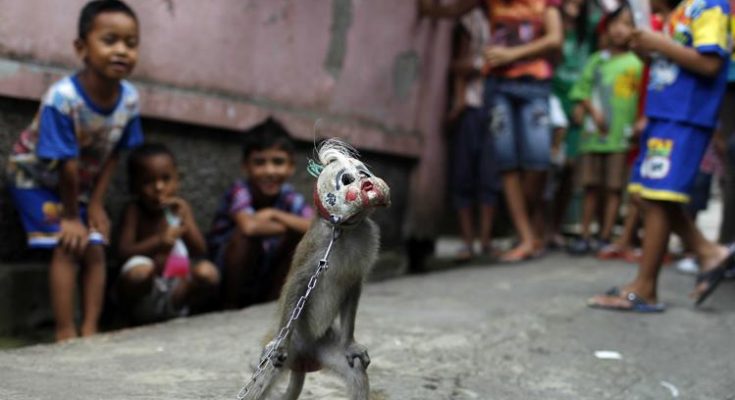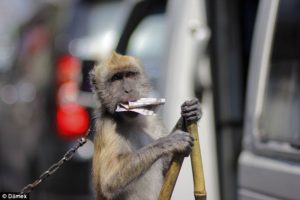by Matthew Isaac Cohen
“Sarimin goes… to the market!” shouts the showman. “Da-da-dum, da-da-dum, da-da-dum” beats the drum. And the monkey goes through its routine. It picks up a doll-size mirror, looks at its reflection, and then discards the prop. The monkey’s handler casually tosses a parasol and handbag to his charge. It picks these up and walks around in a circle. The monkey then takes home its ‘shopping’ in a basket. Other items precede and follow: going to the rice fields pulling a wheelbarrow or with a hoe over its shoulder; carrying a pikul (pole with baskets balanced on both ends); doing a hobby horse dance; saluting the flag; kicking a soccer ball; jumping through a hoop. Repetitive drumming accompanies every movement and there is brief voiceover in Indonesian to explain the mimetic actions. The monkey gets out of line, hissing at the children crowding around it, and the handler yanks on the chain attached to its collar. Occasionally the wayward monkey grabs food or drink from an unwary child and scampers off, as far as its chain extends, to gulp down his spoils. A dancing dog or bendy snake brings the show to its grand finale.
The monkey show, known as topeng monyet in Jakarta, doger monyet in Sunda, ronggeng monyet in East Java, ledhek kethek in Central Java, and komedi monyet in parts of eastern Indonesia, is a festive part of Indonesian street life. Indonesian monkey shows are viewed generally as peripheral culture and the showmen who tour with their small menageries of monkeys, dogs, and snakes resist ascribing any symbolic significance onto the stock images of their trade.
Monkey Shows: Not just an Indonesian phenomenon
Similar sorts of shows, in which monkeys are dressed anthropomorphically and perform human tasks, are found in many countries around the world, or were practiced until the recent past. Italian organ grinders and their ring-tail monkeys were fixtures of American and British public culture until the early twentieth century. Today the form is known mostly from Saturday morning cartoons, but in the past, the public image of the organ grinder was a strong determinant in ethnic stereotyping of ‘the Italian’.
In Japan, monkey performance is the traditional domain of burakumin, an ethnic population considered a pariah caste in pre-modern Japan. Anthropologist Emiko Ohnuki-Tierney, in her historical ethnography, Monkey as Mirror, sees a complex relation between monkeys and their burakumin trainers. Both are marginal beings. Much of the comedy of Japanese monkey shows comes from seeing the monkey outwitting his human trainer. Ohnuki-Tierney understands this running joke as subtle social commentary on the arbitrariness of the divisions in Japan’s hierarchical society. Monkey shows in India are likewise associated with low caste and untouchable performers, but here the mediating figure of the monkey god Hanuman elevates the entertainment to the sacred sphere.
No such sacred aura or evident social agenda seems to inform the Indonesian monkey show, although the form’s ubiquity means that it is often used as a symbol—standing sometimes for lowbrow culture, sometimes for political manipulation. An Indonesian theatre artist, despairing of the severity of censorship in a Jakarta theatre, once quipped that all that could be safely performed there was topeng monyet. Political analysts speak of politicos and their lackeys as monkey handlers and monkeys.
Indonesian traditions of men and women dressing up as monkeys and performing simian acrobatics appear to be quite old and widespread. A selection of living manifestations includes: the Balinese kecak, or so-called monkey dance; the popular figure of Hanuman in Javanese wayang wong; and the Javanese folk acrobatic genre of kethek ogleng from Gunung Kidul, Wonogiri, and Pacitan. West Javanese tales of sentient apes, ‘Lutung Kasarung’ and ‘Ciung Wanara’, are among the best known items in the pantun repertoire of sung narrative poetry in Sundanese. The very first Indonesian fictional film, released in 1926 by the Java Film Company, was Loetoeng Kasaroeng, a now-famous ‘man-as-monkey’ tale, which was based on an innovative Sundanese dance-drama, premiered at a 1921 Javanology congress in Bandung.
The human embodiment of the ape continues to provide inspiration for contemporary artists, including Indonesian choreographer Sardono W. Kusumo, recipient of the Distinguished Artist Award from the International Society for the Performing Arts in 2003. Sardono explains in his autobiographical essay, ‘Hanuman, Tarzan, Pithecanthropus Erectus’, that his first break with the strict codification of Javanese classical dance came through exploring simian movement as preparation for the role of Hanuman in the Sendratari Ramayana at Prambanan. The colossal 40×13 metre stage of this dance-drama spectacle required broader gestures than those available from traditional wayang wong interpretations of the man-ape, and so Sardono drew upon the distinctly “asymmetrical and expressive poses” of Tarzan comics. Sardono recognizes this rupture with tradition, in his impersonation of the Honorable White Ape, as the beginning of his four-decade career as an experimental dance-theatre artist.
A Symbol of Superiority?
The contrast between man impersonating monkey and monkey imitating man is interesting. When actors imitate monkeys in performance, the monkey is ennobled as a hero, harking back to the monkey god Hanuman. In wayang kulit (shadow puppetry) scenes featuring the Honorable White Ape, puppeteers moralize about relations of homo sapiens to the natural order; they may also discourse on Darwin. When monkeys perform anthropomorphic acts in performance, on the other hand, the most common comment is that the monkey is lucu—funny, amusing, cute, queer. The monkey emphatically does not blur lines separating humans from animals, but rather reifies them. The most pleasurable moments in performance come when the animal fails to perform its appointed task in a spectacularly ridiculous manner. The monkey show exalts even the youngest child or poorest person—by actively positioning homo sapien as simian’s superior.
The difference in meaning is related to the different origins of the two sorts of mimetic activity.
In contrast to the antique trove of simian imitation, there is no evidence suggesting that entertainments with actual trained monkeys were performed in the Indonesian archipelago before the late nineteenth-century. The Indonesian monkey show can be traced back to itinerant foreign companies such as Abell, Klaer and Olman’s Circus and Bartelle’s Variety Company, which brought animal acts from Europe, the United States, India, China, and Australia to the heterogeneous publics of colonial Indonesia starting in 1848. Large-scale circuses, known locally as komedi kuda or ‘horse shows’, had elephants and tigers, aerialists and clowns and played in canvas tents pitched in public squares to audiences of thousands. Tiered seating, with ticket prices that, one hundred years ago ranged from 0.25 to 2.00 guilders (roughly US$2- $16 in today’s currency), reproduced colonial society’s class hierarchy. Spectators watching animal acts were flattered into attitudes of superiority over fellow spectators occupying less comfortable seats and over the abject animals forced to perform before them. The ideal and typical attitude at a colonial circus was laughter at, not laughter with.
An 1891 promotion for Abell and Klaer’s circus in Surabaya describes a “tightrope walking monkey, who performs like a person, another monkey who rides a horse” and “astonishing dogs that can jump up high, climb tall ladders, and can do acrobatics like Europeans” [Pembrita-Bahroe, 27th June 1891]. Another promotional piece for the same run promised that “when one see the monkeys and dogs that have been trained to perform like humans, a spectator will be astonished, and some will laugh to see the actions of these animals” [Bintang Soerabaia, 27th June 1891].
Smaller itinerant outfits with trained dogs and monkeys played marketplaces and empty lots to predominately lower class ticket holders. In Madiun’s marketplace in 1893, for example, children paid three cents and adults four cents to be admitted to a monkey show from Gembong (Pasuruan), described as topeng monyet. Though the enclosure was cramped, spectators of all races attended daily, laughing at the “clever monkey trained to be like a person” [Bintang Soerabaia, 20th August 1892].
An Indian (sa’orang Kling) is said to have presented a show with two monkeys and a goat in the small town of Lekok (also in Pasuruan) in 1900. Spectators paid 10 cents for admission and they “all laughed out of enjoyment” [Bintang Soerabaia, 4th August 1900].
An 1899 account describes a Chinese man “just arrived from China, who brings with him a monkey and is busking in the kampung,” or urban wards, of the town of Probolinggo. “It costs 0.25 to hire one act. It is indeed an excellent performance. It can put on a mask by itself and wear a hat and costume like in Chinese opera, and it can dance in a very amusing fashion” [Djawi-Kando, 25th April 1899].
This Chinese show, though differing in content with today’s topeng monyet, concords with the way monkey shows are generally sponsored. Monkey showmen are street entertainers who busk (bebarang in Javanese) in kampung, wandering and beating their drums to attract business. Most shows are manned by only a single handler, who both plays the drum and provides the running narration while he puts his animals through their paces. Some shows are composed of a husband and wife team, which allows for more complex drumming but decreases the profit margin. A very small number of troupes have three performers—animal handler, drummer, and saron (metallaphone) player. A potential sponsor who wants to hire a troupe, usually under the pretence of entertaining a child or grandchild, will wave or call out to the troupe as it passes by. The sponsor will first fix a price for the show (typically Rp 10.000-20.000) and then the act is set up in an area providing maximum exposure. Neighbourhood children and their caregivers will flock to the performance as soon as the show begins. When the show is over ten or fifteen minutes later, the sponsor will pay the troupe, perhaps offering extra money or refreshments if he is especially pleased, and the troupe will continue on its way. Sometimes they will be trailed by gleeful and chattering children eager to catch the next show.
Street busking (bebarangan) is typically seasonal work. Rural musicians and dancers hit the roads during the rainy season when there is little to be done in the rice fields and few opportunities to perform at weddings, circumcisions, communal festivities, or like celebrations. In Central and East Java, cokekan musical groups with zithers and singers still conform to this pattern. Patrons hire cokekan ensembles to do a suite of songs, and might engage a group for a night as well to enliven a low-key social function. In coastal West Java, one occasionally runs into wewean mummers, one or two dancers dressed in ogre masks and accompanied by simple drumming. Many other traditional bebarangan forms, from hobby-horse trancing to ronggeng social dancing, might be mentioned as well. Ethnomusicologist Endo Suanda has argued that bebarangan played a vital function in the arts economy of traditional Java. It allowed younger performers to hone their skills through touring. Occasionally more experienced performers would be invited to teach or become artists in residence in noble houses. (This was how many Cirebonese music and dance forms entered the Sundanese highlands in the nineteenth- and early twentieth centuries.) And most importantly, bebarangan allowed artists to maintain themselves as artists during times of shortage.
The monkey show is also a form of bebarangan, but it provides full time work. Monkey shows are on the streets regardless of season or time of year. Many Java-based showmen commute daily by public transport from their homes to the cities and towns where they perform, but some are on the road constantly, island-hopping between Sumatra, Java, and other parts of the archipelago with high population densities. On the road, showmen and monkeys live together, eating the same food and often sharing the same temporary accommodation. Showmen tend to be clustered in one natal village. The village of Unjunggebang, outside of Cirebon, fields a half dozen or so monkey shows that travel around the archipelago, while a single village outside Madiun—which is reputed to be the place where topeng monyet was invented—had more than two dozen active troupes when I visited in 1990. Such clustering makes good economic sense, as while the showmen require little training and there is little art involved in the making of props, trained monkeys are a valuable commodity, and frequently change hands among fellow villagers.
The Dutch colonial and the Indonesian governments have long been suspicious of travelling players of any sort. Viewed as ‘rogues and vagabonds’, itinerant performers have been required to possess travel passes and permits for over a hundred years. Obtaining these papers can be costly, due to the endemic corruption that is a legacy of the colonial past. In the years following the violent regime change of 1965-1966, all busking was strictly forbidden, and while this ban was later lifted, street performers did not return to the pre-1965 numbers. The last four decades have instead seen a major rise in ngamen—singing beggars who board busses with their guitars, accost drivers at busy intersections, and interrupt diners at outdoor cafés. Few of these beggars have artistic aspirations, and a patron shells out 100 or 200 rupiah to get them to stop singing, not as a token of appreciation. Trained bebarangan performers must compete for public attention with such untrained performers, to the detriment of the former.
Nostalgia
The pervasiveness of the monkey show in Indonesia has not gone without official recognition. Topeng monyet was performed in the ‘Javanese villages’ constructed at the Exposition Universelle in Paris in 1889 and at the World’s Columbian Exhibition in Chicago in 1893. Occasionally, monkey show competitions are held in Jakarta and other parts of the archipelago, with prizes for best trained monkeys, most colourful props and most entertaining act. Monkey shows are regularly performed at Taman Mini Indonesia Indah, the nationalist theme park constructed by Ibu Tien Suharto in Jakarta. Painters such as Sudjana Kerton create images of monkey shows. Film and television shows have plots and subplots about monkey shows. A number of songs about the monkey show have been written—most recently by the innovative Tegal puppeteer, Enthus Susmono. Showmen have been occasionally targeted for ‘upgrading’ and ‘development’, and encouraged to introduce propaganda into their shows by government officials. In contrast to the furore evoked by dancing bears in roadside shows in India or dogs in ‘Punch and Judy’ shows in Britain, Indonesian animal rights activists have not actively targeted the monkey show for the abuse of performing animals.
Many young parents who grew up with topeng monyet in the 1970s and 80s have great nostalgia for this form of entertainment, but there is concern among some that it might not have a long future. Showmen complain of competition from modern media and toys. Children whose parents played, ran, sang and danced in the streets are now often shut off in a private space in front of a television or PlayStation. Little recognition has been given to this vital street entertainment by governmental organizations or foundations; official projects to engage Indonesian children with cultural heritage focus mostly on classical art forms.
One possible area of growth for the monkey show might be birthday parties. Kathputli string puppeteers in India, Punch professors in England, and children’s entertainers around the world have fitted their traditional arts to suit the leisure demands of middle class clients. Monkey shows are less amenable to such adaptation as elite housing developments often do not have suitable spaces for shows and hygienic regulations prevent animals from entering McDonalds.
In a modest effort to raise awareness of topeng monyet, I sponsored a showman to perform at my father-in-law’s house in Solo, Central Java, for my daughter’s fourth birthday in 2002. Many of the neighbours invited to the function were shocked to hear of a raucous street show’s inclusion in a genteel birthday party with a Winnie-the-Pooh birthday cake, gift-wrapped presents, customary religious invocation, party favours, formal handshakes, and boxed food to bring home. Nobody anticipated the rapt attention and squeals of delight the monkey’s antics evoked from children of all ages. More than two years later, my daughter still talks of how the “naughty” monkey stole punch and birthday cake. There are dangers in making such hires. There is no guarantee—even with a down-payment as inducement—that a troupe will turn up at a prearranged time. Some monkeys are more ‘naughty’, and some children more fearful of animals, than others. Possibly, the future of topeng monyet will hinge on the ability of its showmen to adapt to the current age of mobile telephones, increased awareness of health and safety and the involvement of non-governmental organizations in the arts and entertainment of Indonesia.












